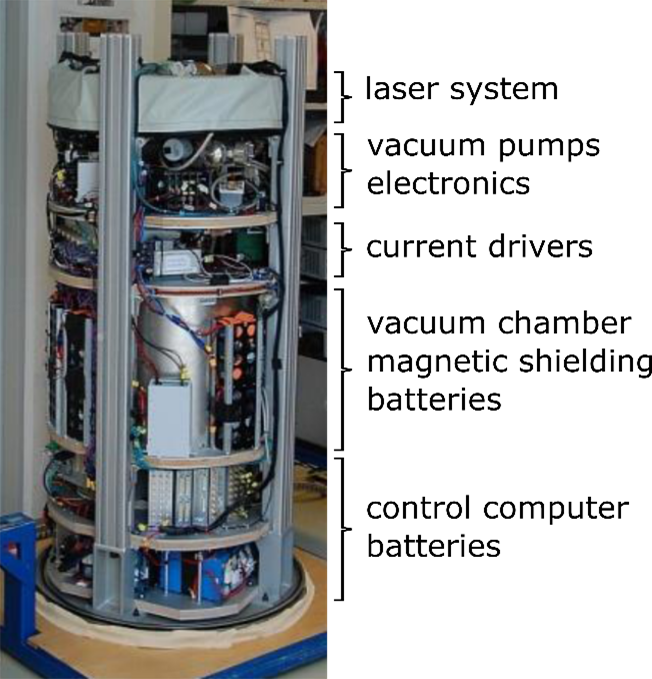
The drop tower features a 120m high evacuable steel tube in which experiments can be dropped from the top which results in a free fall time of up to 4.7s. As the tube can be evacuated residual accelerations as low as 10-6g can be achieved, allowing for very high micro-g qualities. Next to the drop mode, the drop tower also features a catapult mode, in which an experiment is shot up from the bottom, effectively doubling the free fall time to up to 9.4s.
However, due to the special environment also special requirements are laid upon the experiments to be conducted in the drop tower. These requirements include limits on weight, volume and power consumption and demand from the experiment to be robust and completely remote controllable.
To comply with these requirements the QUANTUS-2 apparatus was developed.
All required subsystems, namely laser system, vacuum system incl. coils and optics, electronics system, control system and batteries were integrated into a drop capsule measuring Ø0.6x1.2m (see picture of capsule).
The atoms are cooled in a 2D+/3D-MOT setup and transferred into a Ioffe-Pritchard type trap generated by a multi-layer atom chip. This approach combines a very fast cycle time with a long life time of the trapped atoms and a low power consumption. In the magnetic trap the atoms are then further cooled to quantum degeneracy via RF evaporation. This approach allows for the creation of a Rb BEC in only 1.6s.
After the generation of the BEC numerous experiments are carried out studying properties of the atoms and the feasibility of BECs for precision measurements in space.
These experiments include studies of the dynamics of the trapped atoms, manipulation of internal as well as external states, e.g. transfer of the atoms into the non-magnetic state mf=0, or delta-kick collimation, and atom interferometry.
Especially the delta-klick collimation (DKC) is of great interest as the preparation of atomic ensembles with kinetic temperatures below the pK-range is one of the main prerequisites for high precision atom interferometry with interrogation times of several seconds or even several tens of seconds.
With the QUANTUS-2 apparatus the expansion velocity of the BEC could be reduced to below 77µm/s in all three dimensions which corresponds to an effective three-dimensional temperature of as low as 38pK. This allows us to detect the BEC after a free evolution time of up to 2s.
The two mayor next steps will be the investigation of atom interferometry and the implementation of Potassium. Currently we are only experimenting with atomic Rubidium but as a step towards a test of the universality of free fall we want to integrate Potassium as well, to be able to perform dual species atom interferometry with Rubidium and Potassium atoms.
Apart from the science itself this apparatus serves also as a test bed for the space missions MAIUS and BECCAL. This is due to the very similar requirements the drop tower lays upon the experiments compared to those missions. Experiments for both platforms need to be mechanically robust, compact, light-weight, remotely controllable and feature a low power consumption.
Next to synergies concerning the hardware also scientific concepts and experimental sequences can be tested in the drop tower before they are used in larger (and more expensive) space missions.
These concepts which are pursued in QUANTUS-2 are e.g. the investigation of shell potentials, of atom lasers, or of rubidium-potassium-mixtures.
Main Publications:
[1] “A high-flux BEC source for mobile atom interferometers“ J. Rudolph et al, 2015 New J. Phys. 17 065001 [2] "Interferometry with Bose-Einstein Condensates in Microgravity", H. Müntinga et al, Phys. Rev. Lett. 110, 093602 [3] "Bose-Einstein Condensation in Microgravity", T. van Zoest et al, Science 328 (5985) [4] “Collective-mode enhanced matter-wave optics”, C. Deppner et al, 2021, to be published